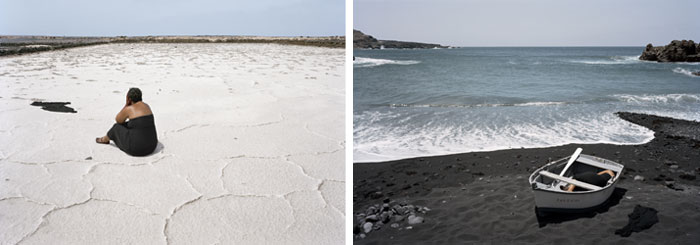
Michael Stevenson Hill House De Smidt Street, Green Point Cape Town Afrique du Sud
Michael Stevenson is pleased to present a solo exhibition by Berni Searle, featuring a number of major new video works made this year.
This will be Searle's fourth solo exhibition at Michael Stevenson, following Crush in 2006, About to forget in 2005, and Vapour in 2004. As in all these previous shows, Searle's work draws on the particularities of her own cultural heritage, invoking the rituals and traditions that persist through generations and continue to bind communities together long after the circumstances of their genesis have passed or been forgotten. Yet the lyrical, abstracted nature of her visual imagery ensures that her work transcends the specific and extends to global themes such as belonging and displacement, nationalism and xenophobia.
One of the new videos, Alibama, premiered at the Haunch of Venison gallery in London in May as part of the South African exhibition Home Lands - Land Marks. It takes as its central motif the traditional Cape song, Daar Kom die Alibama, which is thought to refer to the sighting of the Confederate ship, the Alabama, in Table Bay in 1863. Footage of the sun setting over the harbour, accompanied by the singing of a Cape Malay choir, is disrupted as the camera pans over Robben Island and the noon gun fires its daily blast - powerful signifiers of time and place, both historical and contemporary. The film then shifts to a more intimate register, its soundtrack the artist teaching the song to her young son, who sings along until he falls asleep, while black streamers bleed colour into the water surrounding a red paper boat.
Another body of work, commissioned by the Centro Atlántico de Arte Moderno in Las Palmas, Canary Islands, focuses on ideas around migration. Shot on the volcanic island of Lanzerote, the video and related photographs titled Seeking Refuge situate the artist within a stark, beautiful landscape that is manifestly inhospitable, yet within which people have found ways to survive.
The exhibition also features a four-screen video installation commissioned by the On the Edge project in Obrestad, Norway. Here the camera occupies the position of the light bulb within the circular formation of the lenses of a lighthouse. In the resulting footage, the landscape - with the artist walking through it - is seen to rotate, alternately inverted (when viewed through the lenses) and not, playing with our perceptions of what is real and imaginary.
Finally, in a two-screen video projection titled Mute, Searle responds emotively to the xenophobic violence that has wracked this country.
Since her solo show at Michael Stevenson in 2006, Searle has had survey exhibitions at Johannesburg Art Gallery (2006) and the Contemporary Art Museum, University of South Florida (2006), travelling to the Krannert Art Museum, University of Illinois (2007). She was one of three artists selected for the annual New Photography exhibition at the Museum of Modern Art, New York (2007). Her work has featured on numerous group exhibitions in the past year, including Black Womanhood: Images, Icons, and Ideologies of the African Body at the Hood Museum of Art, Dartmouth College, USA; Apartheid: The South African Mirror at the Centre de Cultura Contemporania, Barcelona; and Global Feminisms at the Brooklyn Museum, New York.
A catalogue of works with contributions by Tamar Garb, Annie Coombes, Gabeba Baderoon and Marion Arnold, among others, will be published during the course of the exhibition.
Searle will exhibit concurrently with Youssef Nabil. The exhibition will open on Thursday 4 September, 6 - 8pm.
Searle will give a walkabout of her exhibition for the Friends of the National Gallery on Thursday 11 September at 11am. All are welcome; cost is R20 (members and non-members).
The gallery is open from Monday to Friday, 9am to 5pm, and Saturday from 10am to 1pm.

